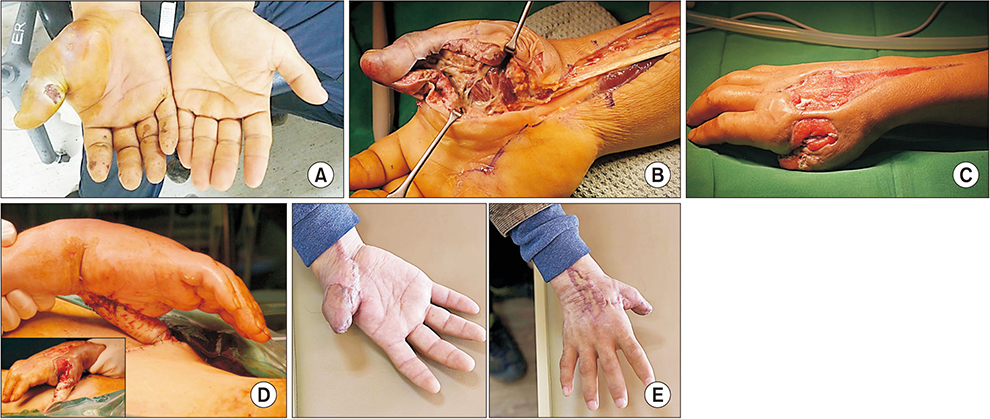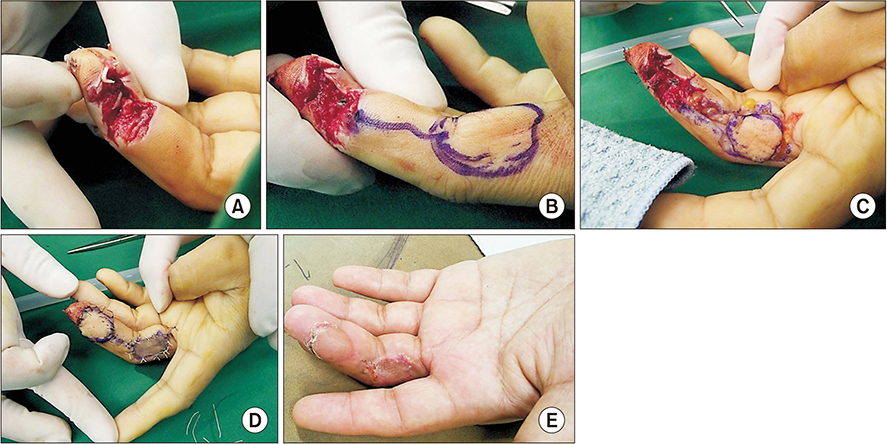Arch Hand Microsurg.
2019 Sep;24(3):225-233. 10.12790/ahm.2019.24.3.225.
Outcomes of Neglected Paint Gun Hand Injuries: Neglected Patients
- Affiliations
-
- 1Department of Orthopedic Surgery, Hallym University Sacred Heart Hospital, Anyang, Korea.
- 2Department of Orthopedic Surgery, Chungnam National University School of Medicine, Daejeon, Korea. hyunsd@cnu.ac.kr
- KMID: 2456246
- DOI: http://doi.org/10.12790/ahm.2019.24.3.225
Abstract
- PURPOSE
We report a retrospective case series of patients who received delayed treatment for a paint gun hand injury.
METHODS
From January 2001 to December 2016, 13 patients injured from the fingertip to the wrist and treated surgically after a 48-hour delay was evaluated. Basic demographic characteristics, injury mechanism, lesion, time-to-surgery, and degree of injury were investigated. The visual analogue scale (VAS) scores; Disabilities of the Arm, Shoulder, and Hand (DASH) scores; and Strickland evaluations were analyzed at least 2 years after injury.
RESULTS
The surgery was performed at a mean 59.7 hours after injury. Soft tissue coverage was performed at a mean 8.2 days after the initial incision and debridement, and simple skin closure and full-thickness skin grafting were performed in 1 and 7 patients, respectively. Moreover, cross-finger flap, neurovascular island flap, retrograde island flap, and groin flap were used in one, one, one, and two patients, respectively. The mean follow-up period was 28.2 months, and the mean VAS and DASH scores were 0.92 and 36.3, respectively, whereas the outcomes of the Strickland evaluations were "˜good' in two patients, "˜fair' in seven patients, and "˜poor' in four patients.
CONCLUSION
The recent mechanical development of paint guns has led to an increase in high-pressure injection injuries and resulted in greater accidental toxic paint injection into the fingers and hand. Thus, the toxic and inflammatory response progresses rapidly to acute compartment syndrome and necrosis, and delayed treatment is therefore associated with poor clinical outcomes.
MeSH Terms
Figure
Reference
-
1. Verhoeven N, Hierner R. High-pressure injection injury of the hand: an often underestimated trauma: case report with study of the literature. Strategies Trauma Limb Reconstr. 2008; 3:27–33.
Article2. Bekler H, Gokce A, Beyzadeoglu T, Parmaksizoglu F. The surgical treatment and outcomes of high-pressure injection injuries of the hand. J Hand Surg Eur Vol. 2007; 32:394–399.
Article3. Wieder A, Lapid O, Plakht Y, Sagi A. Long-term follow-up of high-pressure injection injuries to the hand. Plast Reconstr Surg. 2006; 117:186–189.
Article4. Hogan CJ, Ruland RT. High-pressure injection injuries to the upper extremity: a review of the literature. J Orthop Trauma. 2006; 20:503–511.
Article5. Hart RG, Smith GD, Haq A. Prevention of high-pressure injection injuries to the hand. Am J Emerg Med. 2006; 24:73–76.
Article6. Chaudhry S, Gould S, Gupta S. High-pressure paint gun injection injury to the palm. Am J Orthop (Belle Mead NJ). 2013; 42:379–382.7. Canedo JMG, José LRS. High-pressure injection injury of the hand. Int J Fam Commun Med. 2018; 2:161–163.
Article8. Strickland JW, Glogovac SV. Digital function following flexor tendon repair in Zone II: a comparison of immobilization and controlled passive motion techniques. J Hand Surg Am. 1980; 5:537–543.
Article9. Kim BS, Ko SH, Cho SD, Lew S, Lee JY, Park MS. Treatment of a high pressure injection hand injury. J Korean Orthop Assoc. 2003; 38:514–518.
Article10. Stark HH, Ashworth CR, Boyes JH. Paint-gun injuries of the hand. J Bone Joint Surg Am. 1967; 49:637–647.
Article11. Christodoulou L, Melikyan EY, Woodbridge S, Burke FD. Functional outcome of high-pressure injection injuries of the hand. J Trauma. 2001; 50:717–720.
Article





